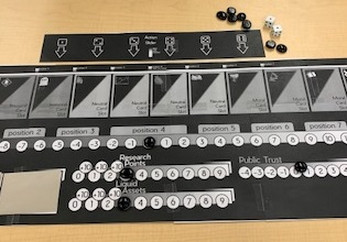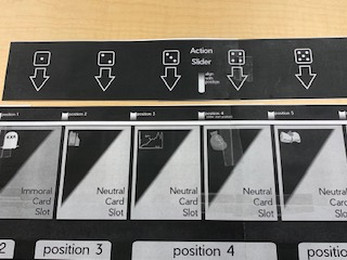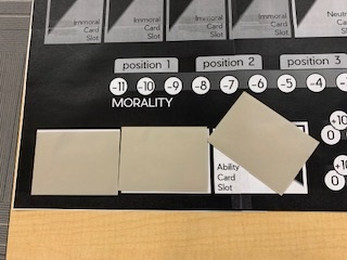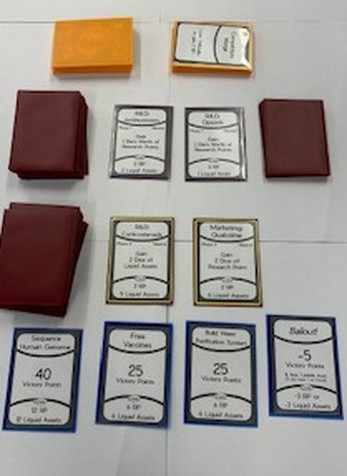
Big Pharma Inc.
A downloadable game
About
This game simulates ethical decision-making and organizational action in the pharmaceutical industry. Decision choices and possible actions are shaped by a variety of internal and external variables including leadership, regional and global industry structure, and public policy. As you progress through the game future decisions are shaped by past ones and each action becomes more critical in terms of the ultimate outcome.
Object of the game
Achieve the highest score by accumulating liquid assets, research points, and public trust. The key to winning is making trade-offs between morally right, wrong, and neutral actions.
Setup
- Each player selects a player mat. (see Screenshot 1)
- Align the position marker on the action slider to the Position 4 mark on the action tracker. (Screenshot 2)
- Each player receives a handful tokens to use on the morality, liquid assets, research points, and public trust scales.
- Each player begins with 3 liquid assets, 3 research points, and zero public trust points. (see Screenshot 1)
- Draw three ability cards and place face down on the slots on the game mat. (see Screenshot 3)
- Deal cards until you find three neutral cards for each player. Ensure that each player has at least one R&D and one marketing card. Players should place their three neutral cards in the available neutral card slots in the center of the action track. Shuffle the remaining cards well.
- Place the rest of the action cards in the center of the table. Turn two faced up in a row. (see Screenshot 4)
- Sort orange event cards and then draw and shuffle together:
- Two player game, 16 cards (8 event + 8 false alarm)
- Three player game, 24 cards (8 event cards + 16 false alarms)
- Four player game, 32 cards (8 event cards + 24 false alarms)
- Place in the game area as indicated on Screenshot 4)
- Place the blue victory point cards face up in two stacks on the table. One stack is bailout cards and one stack is all the rest. Players may look through and purchase one of these at the beginning of their turn. (see Screenshot 4)
- Roll to see who goes first.
Cards
Ability cards (beige sleeve): Individualized choices that players can make to modify their actions and the consequences of their actions during the game. Each card can be used once during the game. They should be turned face up when they are used.
Action cards (burgundy sleeve) have to be purchased with the liquid assets, research points, and public trust accumulated across the game. There are three types of action cards: morally wrong, neutral, and morally right actions.
- Morally wrong: Twelve available actions. For each action, there is a possible consequence, which can be either a reward or a penalty. The determination is made by rolling the die.
- Neutral:
- Marketing cards: Each marketing card represents investment in marketing for a particular product and generates liquid assets. The amount earned is determined by rolling the die.
- R&D cards: Each R&D card represents investment in research and development in a particular class of drugs and generates research points. The amount earned is determined by rolling the die.
- Morally right: Twelve available actions. For each action, there is a possible consequence, which can be either a reward or a penalty.
Event cards (orange sleeves): Turned over at the beginning of each turn. Action indicated applies to all players.
Victory point (VP) cards (blue sleeves): Victory point cards offer significant rewards.
Bailout cards (blue sleeves): Can be activated at the beginning of a players turn. Use to obtain three liquid assets or three research points. Use of this option is not limited.
Gameplay: Phase I
Gameplay comprises two phases, eight rounds each. A round is complete when all players have taken a turn. To take your turn:
- Turn over one event card. All players take the action if one is indicated. If it’s a “false alarm” do nothing.
- Then decide whether or not to purchase one of the action cards that’s showing.
- If no purchase is made, turn the oldest card over to create a discard pile (use this discard pile throughout the game). Then, shift the remaining card over and flip another card over from the stack so that there are still two cards face up in a row.
- If a purchase is made do not make a discard, simply turn over another card.
- Roll die. Then, complete the action on the card indicated by the number on the slider that corresponds to the number rolled. If you roll a number that is empty in the corresponding slot indicated by the action slider you do not get to take any further action.
- This completes your turn. Pass die to next player.
The game phase ends when the last event cards for that phase have been used (each player gets 8 turns). The game ends when all phases are complete.
Setup for Phase II
When Phase I ends (after all orange event cards are used) do the following:
- Do not make any changes on the player mats.
- Do not remove Phase 1 action cards.
- Do not remove blue victory point cards.
- Shuffle the orange event cards.
- Add Phase II action cards. They will be their own stack/showing/discard piles run in parallel to the Phase I action cards. Turn over two cards (as you did initially for the Phase I cards). Refer to Screenshot 5.
Game Play: Phase II
To take your turn:
- Turn over one event card. All players take the action if one is indicated. If it’s a “false alarm” do nothing.
- Then decide whether or not to purchase one of the action cards that’s showing (Phase I and Phase II cards are now available).
- If no purchase is made, turn the oldest card showing for Phase I over and add to the discard pile. Then, shift the remaining card over and flip another card from the stack so that there are still two cards face up in a row. Repeat this step for the Phase II cards.
- If a purchase is made do not make a discard, simply turn over another card to fill the empty slot. For the cards that were not affected by the purchase, follow the preceding step.
- Roll die. Then, complete the action on the card indicated by the number on the slider that corresponds to the number rolled. If you roll a number that is empty in the corresponding slot indicated by the action slider you do not get to take any further action.
- This completes your turn. Pass die to next player.
When Phase II ends when all orange event cards are used. Do final scoring and announce the winner!
Final scoring
When the final round is complete each player should do the following:
- Multiply public trust points by three.
- Add together your liquid assets, research points, and public trust points.
- Add victory points to your total.
- Subtract bailout penalty.
The person with the highest points wins.
Glossary
Action tracker: A twelve slot tray that holds the action cards purchased by the player. Cards are placed along a range from saintly actions (on the right) to morally bankrupt actions (on the left). See description of action cards above.
Liquid assets: Represents the amount of cash available to be spent.
Morality tracker: Tracks the morality of the company.
Public trust: A resource that may be increased or decreased by certain actions in Phase 1. In Phases 2 public trust must be spent to take certain actions. Public trust points are added the final score at the end of the game.
Research points: Represents the value of research compiled to date. Research points can be spent like currency.
Slider: Defines the range of possible actions that a player can take. The position of the slide is tied to the score on the morality scale.
| Status | Released |
| Category | Physical game |
| Author | TedwardCz |
| Genre | Card Game, Simulation |
| Tags | business, corporate, decision-making, ethics, morality |





Leave a comment
Log in with itch.io to leave a comment.